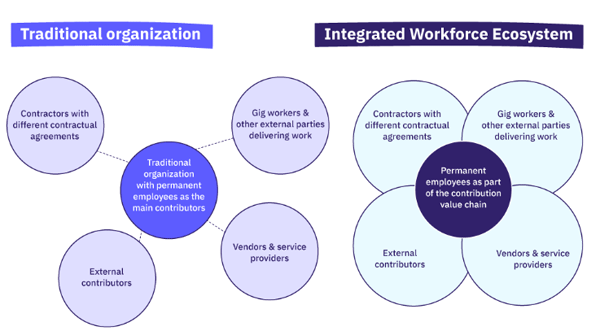While HR has traditionally focused on permanent employees, other types of workers such as contractors, gig workers and employees working for supply chain partners play an increasingly important role in company service delivery.

In the US alone, 16% of Americans have made money through gig platforms. According to ADP, at about 40% of companies, one in four workers is a gig worker. This means that a large portion of the total workforce goes unmanaged and HR misses an opportunity to make an impact.
We believe that 2023 is the year that HR will begin to manage complex workforce ecosystems beyond permanent employees. This has three effects.
First, HR will be actively involved in managing its contingent workforce. They will integrate contractors, gig workers and external contributors into the HR value chain. This must be done not only from a value creation perspective but also from a risk perspective. HR’s current, often hands-off, attitude towards temporary workers creates a two-tiered workforce that even leading companies like Google struggle to adequately manage.
Second, in today’s platform economy, HR can contribute to creating a more blended workforce ecosystem by adding value to external contributors.
Uber is the largest taxi company without drivers, Airbnb is the largest hotel chain without properties, while platforms like YouTube, Netflix and TikTok outsource most of their content creation. These organizations are highly dependent on their contributors. HR has a role to play in making these contributors part of their people practices.
And third, HR should share best practices with supply chain partners, vendors, and service providers.
The (post)pandemic era has shown the importance of the value chain from a production point of view and a reputational point of view. For example, Rihanna’s fashion label Fenty Beauty was accused of using child labor in its supply chain.
HR may not drive partnership decisions, but there is a unique opportunity to reinforce best people practices across the supply chain.
Examples of what we will see in 2023 include creating communities of expertise, mentoring programs for experienced HR professionals, and job rotation across the supply chain. Business is not a zero-sum game, especially when it comes to partners. This is one area where HR can create tremendous value through the workforce ecosystem.
Workforce Ecosystem
Our study introduces the concept of a workforce ecosystem, which we define as “a structure focused on value creation for an organization that consists of complementarities and interdependencies. This structure includes actors from within and outside the organization, both individual and collective. works to achieve goals. By complementarity, we mean that some members of the system (employees or organizations) work independently yet together provide value for their mutual customers. By interdependence, we mean that some members share their success (or failure). for) depend on each other; they win or lose together.”
A variety of factors are driving this shift toward ecosystem thinking, including the nature of work, employee preferences, and how organizations use technology to engage and manage the workforce. Adoption trends in the workforce ecosystem were well in place before the work-related changes associated with the Covid-19 pandemic, and they are likely to continue after the pandemic subsides. As remote and flexible work has taken root in business practices over the past year, it has likely accelerated workforce ecosystem adoption.
The phenomenon is real, according to interviews with leaders from organizations including the Mayo Clinic, Workday and SAP. Yet our survey found that most organizations are unprepared: Only 28% of survey respondents agreed that their company is “adequately prepared to manage a workforce that will rely more on external participants.”

 Follow
Follow